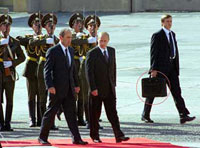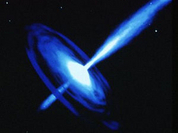First Nuclear Briefcase Appeared in USA under Eisenhower
There are not that many people who are not familiar with the concept of the “Nuclear Briefcase” or “Nuclear Button.” They were invented by Russian journalists working with international issues. They spoke good English, and when they came across a picture of the American President accompanied by an officer with a leather bag, they noticed the caption: Nuclear Football, President's Emergency Satchel, The Button. They read it and began thinking about an appropriate translation. “Nuclear football” did not sound well and was not clear. “President's Emergency Satchel” was a bit better. “The Button” was too drab. They thought a little more, broke the names down, mixed them back together and came up with the “Nuclear Briefcase” and “Nuclear Button,” short and politically correct. It was technically correct as well.

Pioneer Eisenhower
Nuclear Briefcase (NB) was first invented by the Americans.
Devices similar to NB appeared in the US under President Eisenhower (1953 - 1961). At the time, the US had 300 nuclear bombs against the Soviet Union’s 10.
The system took its current shape during the Caribbean crisis, when Kennedy developed doubts about the nuclear arsenal being under his control. He was pressed by both military and civilian people from his administration, who demanded that he “punishes those Russian commies.” First of all, he was concerned that the order regarding a nuclear strike could be given without his consent. Second, he worried that even if such order was necessary, he may not be able to give it without being at the control point. As a result, the nuclear briefcase was invented. Since then, only the US President can order to launch a nuclear missile, even from his own bedroom. Provided his has the nuclear briefcase handy.
“White Yankee”
What does the American nuclear briefcase look like? What is inside?
Generally, the contents and action mechanism are a state secret, but some information is available. This is a black leather bag with a heavy-duty titanium briefcase inside made by Zero Halliburton. The briefcase has a combination lock, weights 39.7lbs and is 17.7x13.8x9.8 inches.
The briefcase is guarded by the President’s special assistant 24/7. It is attached to the assistant’s wrist with a special cord-bracelet. Five such assistants working in shifts are recruited from the US Army and Coastal Guard. The assistants have to pass a rigid background check, and the highest clearance is called “White Yankee.” The assistants are armed, entitled to fire to effect and have to be near the President at all times. The assistant with the nuclear briefcase always stands near the President, walks next to him or sits near him on an airplane, helicopter or in a car. They are the President’s shadows.
Inside the briefcase there are satellite transmitter and the materials that would allow the President to make a decision to use nuclear weapons. The materials include “The Black Book” schematically describing on 30 pages the nuclear attack plan. In the thick of the Cold War this integrated plan included 12.5 thousands of targets on the USSR territory.
The briefcase also contains a list of secret bunkers the President can use in case of a nuclear attack, as well as instructions on connecting with the Pentagon to get recommendations for furtheractions.Therearealso protocols for activation of national emergency announcement system the President can use to address the nation within 10 minutes after announcing the state of emergency regardless of his whereabouts. If the President decides to use nuclear weapons, the security must keep him safe while the assistant opens the briefcase. Then the President and his assistant must choose the appropriate course of actions, and the assistant has to connect with the Pentagon or the airborne command post on Boeing E-4B. For the order to be implemented, the President has to identify himself with a special “golden code,” a laminated “confirmation plate” that looks like a simple credit card. The plate has an alphanumeric code on it, which serves as the order for those who must turn the launch key in mines and on submarines.
Carter sent his “golden code” to a drycleaner
The briefcase is transferred from one President to another on the day of inauguration at noon, when the official transfer of power occurs. Each new resident of the White house is given instructions on how to use the briefcase. Some Presidents of nuclear powers were so used to the guy with the briefcase that at some point they would forget all about it. President Carter almost caused the military people to have heart attacks when he left his “confirmation plate” in a pocket of his jacket he sent to dry-cleaning. Reagan used to carry it in his wallet in his rear pocket, and after the assassination attempt the plate was missing for a while. Ford once left the briefcase along with his assistant on his airplane in Paris. Carter did not allow his assistant to lodge on his farm in Georgia during his vacation, and the assistant had to stay at a motel 10 kilometers away from the President.
The older Bush once left a tennis court in Los Angeles, and the “man in a uniform” had to catch him in a taxi. Clinton outran the rest of the Presidents when he left his special assistant in the middle of the street on the day of the celebration 50-year anniversary of NATO in Washington in 1999. The poor assistant had to run after him for 15 minutes, the heavy briefcase in hand. He did catch him, proving to be an excellent athlete. Clinton’s press secretary Joe Lockhart had to spend some time calming down scared Americans: “Things happen, but we are all safe.”
These are funny cases, but they show that Presidents were convinced in the absolute superiority of the USA, and did not expect the USSR to attack, reserving the right to wage a war.
A bag for the General Secretary
Russian nuclear briefcase was created 20 years later, when the development of nuclear weapons made it possible to strike. The briefcase was designed in the 1970 for Brezhnev, but it took the designers longer than expected, and Chernenko became the first one to be accompanied by an officer with the briefcase. During the presentation of the device, the sample delivered to the Kremlin was tested in the General Secretary’s conference room, but the device only worked when placed on the windowsill.
The briefcase is a part of the automated system of strategic nuclear forces management “Kazbek.” It was introduced in 1983. It is relatively heavy, 24.3lbs. When its photo appeared in a newspaper, the author was almost blamed for breaking a state secret. Even now its pictures are quite rare.
Komsomolskaya Pravda
Subscribe to Pravda.Ru Telegram channel, Facebook, RSS!




